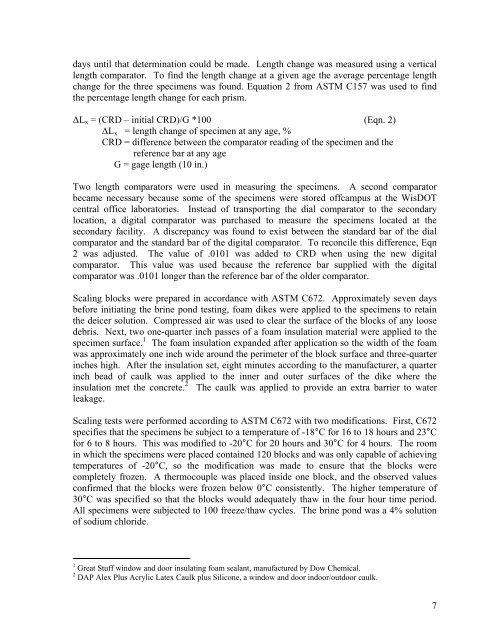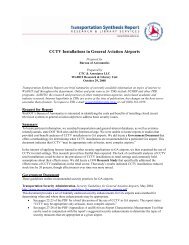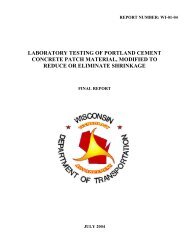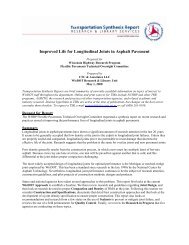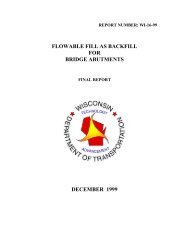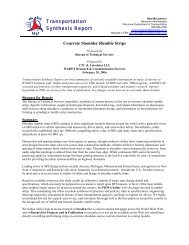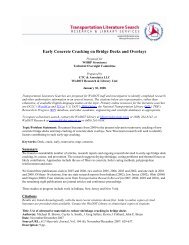Effects of Ground Granulated Blast Furnace Slag in Portland Cement ...
Effects of Ground Granulated Blast Furnace Slag in Portland Cement ...
Effects of Ground Granulated Blast Furnace Slag in Portland Cement ...
Create successful ePaper yourself
Turn your PDF publications into a flip-book with our unique Google optimized e-Paper software.
days until that determ<strong>in</strong>ation could be made. Length change was measured us<strong>in</strong>g a vertical<br />
length comparator. To f<strong>in</strong>d the length change at a given age the average percentage length<br />
change for the three specimens was found. Equation 2 from ASTM C157 was used to f<strong>in</strong>d<br />
the percentage length change for each prism.<br />
∆L x = (CRD – <strong>in</strong>itial CRD)/G *100 (Eqn. 2)<br />
∆L x = length change <strong>of</strong> specimen at any age, %<br />
CRD = difference between the comparator read<strong>in</strong>g <strong>of</strong> the specimen and the<br />
reference bar at any age<br />
G = gage length (10 <strong>in</strong>.)<br />
Two length comparators were used <strong>in</strong> measur<strong>in</strong>g the specimens. A second comparator<br />
became necessary because some <strong>of</strong> the specimens were stored <strong>of</strong>fcampus at the WisDOT<br />
central <strong>of</strong>fice laboratories. Instead <strong>of</strong> transport<strong>in</strong>g the dial comparator to the secondary<br />
location, a digital comparator was purchased to measure the specimens located at the<br />
secondary facility. A discrepancy was found to exist between the standard bar <strong>of</strong> the dial<br />
comparator and the standard bar <strong>of</strong> the digital comparator. To reconcile this difference, Eqn<br />
2 was adjusted. The value <strong>of</strong> .0101 was added to CRD when us<strong>in</strong>g the new digital<br />
comparator. This value was used because the reference bar supplied with the digital<br />
comparator was .0101 longer than the reference bar <strong>of</strong> the older comparator.<br />
Scal<strong>in</strong>g blocks were prepared <strong>in</strong> accordance with ASTM C672. Approximately seven days<br />
before <strong>in</strong>itiat<strong>in</strong>g the br<strong>in</strong>e pond test<strong>in</strong>g, foam dikes were applied to the specimens to reta<strong>in</strong><br />
the deicer solution. Compressed air was used to clear the surface <strong>of</strong> the blocks <strong>of</strong> any loose<br />
debris. Next, two one-quarter <strong>in</strong>ch passes <strong>of</strong> a foam <strong>in</strong>sulation material were applied to the<br />
specimen surface. 1 The foam <strong>in</strong>sulation expanded after application so the width <strong>of</strong> the foam<br />
was approximately one <strong>in</strong>ch wide around the perimeter <strong>of</strong> the block surface and three-quarter<br />
<strong>in</strong>ches high. After the <strong>in</strong>sulation set, eight m<strong>in</strong>utes accord<strong>in</strong>g to the manufacturer, a quarter<br />
<strong>in</strong>ch bead <strong>of</strong> caulk was applied to the <strong>in</strong>ner and outer surfaces <strong>of</strong> the dike where the<br />
<strong>in</strong>sulation met the concrete. 2 The caulk was applied to provide an extra barrier to water<br />
leakage.<br />
Scal<strong>in</strong>g tests were performed accord<strong>in</strong>g to ASTM C672 with two modifications. First, C672<br />
specifies that the specimens be subject to a temperature <strong>of</strong> -18°C for 16 to 18 hours and 23°C<br />
for 6 to 8 hours. This was modified to -20°C for 20 hours and 30°C for 4 hours. The room<br />
<strong>in</strong> which the specimens were placed conta<strong>in</strong>ed 120 blocks and was only capable <strong>of</strong> achiev<strong>in</strong>g<br />
temperatures <strong>of</strong> -20°C, so the modification was made to ensure that the blocks were<br />
completely frozen. A thermocouple was placed <strong>in</strong>side one block, and the observed values<br />
confirmed that the blocks were frozen below 0°C consistently. The higher temperature <strong>of</strong><br />
30°C was specified so that the blocks would adequately thaw <strong>in</strong> the four hour time period.<br />
All specimens were subjected to 100 freeze/thaw cycles. The br<strong>in</strong>e pond was a 4% solution<br />
<strong>of</strong> sodium chloride.<br />
1 Great Stuff w<strong>in</strong>dow and door <strong>in</strong>sulat<strong>in</strong>g foam sealant, manufactured by Dow Chemical.<br />
2 DAP Alex Plus Acrylic Latex Caulk plus Silicone, a w<strong>in</strong>dow and door <strong>in</strong>door/outdoor caulk.<br />
7


